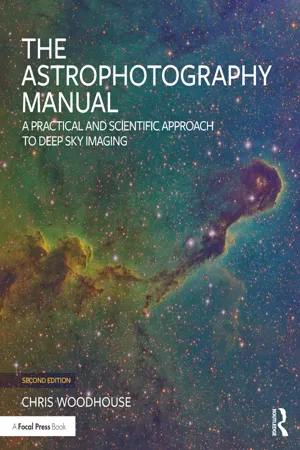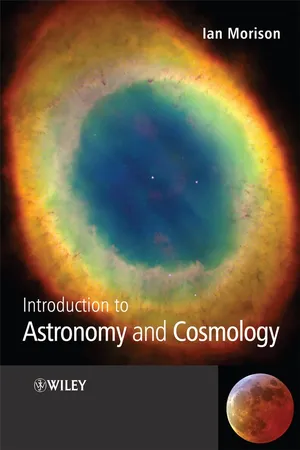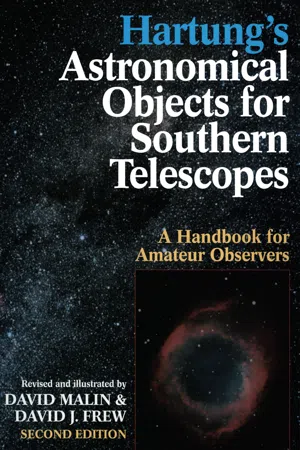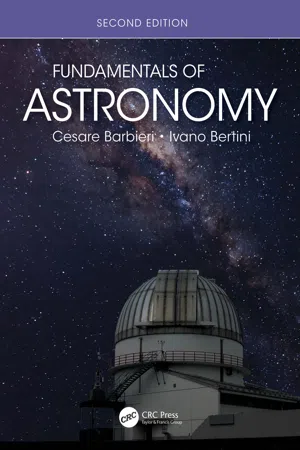Physics
Absolute Magnitude
Absolute magnitude is a measure of the intrinsic brightness of a celestial object, such as a star or galaxy. It is defined as the apparent magnitude the object would have if it were located at a distance of 10 parsecs (32.6 light-years) from the observer. Absolute magnitude is useful for comparing the true brightness of objects, regardless of their distance from Earth.
Written by Perlego with AI-assistance
Related key terms
Related key terms
1 of 4
Related key terms
1 of 3
5 Key excerpts on "Absolute Magnitude"
- No longer available |Learn more
The Astrophotography Manual
A Practical and Scientific Approach to Deep Sky Imaging
- Chris Woodhouse(Author)
- 2017(Publication Date)
- Routledge(Publisher)
This is a measure of an object’s intrinsic electromagnetic brightness and when evaluated in the visual wavelength range is termed absolute visual magnitude. Photographers are aware that the intensity of a light source reduces with distance, for instance the light intensity from a fl ashgun obeys the inverse-square law (for each doubling of distance, the light reduces by 4x). This same is true of cosmic light sources. Absolute Magnitude is similar to apparent magnitude when measured from a fixed distance of 10 parsecs. (Since meteors and asteroids are very dim, compared to the nuclear furnace in a star, they use a magnitude definition set at 100 km and 1 AU distance respectively.) Absolute Magnitude is of most interest to scientists, especially in the computation of an object’s distance. For astrophotographers, the apparent magnitude from Earth is more useful, and for amateur supernova hunting, significant changes in a star’s magnitude, compared to the star’s standard photometry, indicate a possible discovery.Optics
Advertising and consumer pressure tempt us to over-indulge in telescopes purchases for astrophotography. There are many optical and physical properties that distinguish a “good” telescope from a “bad” one, and just like with any other pursuit, knowing what is important is the key to making the correct purchasing decision. In the case of resolution, the certainty of an optical performance, backed up by physical equations, is a beguiling one for an engineer and I have to frequently remind myself that these are only reached under perfect atmospheric conditions (which I have yet to encounter). The needs of the visual observer and astrophotographer are different too since the human eye has a higher resolution than a conventional sensor (though with less sensitivity). Expensive apochromatic refractors focus all wavelengths of light at the same point, a quality valued by visual users or those imaging with a color camera. It has less significance if separately focused exposures are taken through narrowband or individual red, green or blue filters and combined during image processing. - eBook - ePub
Burnham's Celestial Handbook, Volume One
An Observer's Guide to the Universe Beyond the Solar System
- Robert Burnham(Author)
- 2013(Publication Date)
- Dover Publications(Publisher)
If brought to a distance of only 32½ light years, its magnitude would rise to -7.1. Thus its apparent magnitude is 0.14, and its Absolute Magnitude is -7.1. For another example, our Sun, if removed to the 32½ light year standard distance, would appear as a star of magnitude 4.8. This then is its Absolute Magnitude. The figure for Rigel, as we have just seen, is -7.1. The difference is 11.9 magnitudes, which tells us (Table III) that Rigel is about 57,000 times more luminous than the Sun. This example is given to dramatize the obvious fact that there is a definite relation between the apparent magnitude, Absolute Magnitude, and distance of an object. If any two of these quantities are known, the third can be determined. Absolute Magnitude can also be converted directly into actual luminosity in terms of the Sun. (Refer to Table V.) Before ending this brief description of the magnitude system, we must mention one additional point: we have been speaking of “visual magnitudes,” star brightness as seen by the normal eye. Photographic plates and photoelectric instruments “see” the stars differently, and there are thus a variety of magnitude scales—photographic, photoelectric, bolometric, etc. The differences between the various measurements are chiefly a function of the color or temperature of the star; and thus the various scales are inter-related by quantities known as “color indices.” In its simplest and original meaning, the color index of a star is the difference between its visual magnitude and its photographic magnitude. The hotter and bluer stars appear brighter on the ordinary photographic plate than they do to the eye; whereas the redder and cooler stars appear fainter. By agreement, the two scales were set to give a color index of zero for stars of spectral type A0 - eBook - ePub
- Ian Morison(Author)
- 2013(Publication Date)
- Wiley(Publisher)
Figure 6.2 ). GAIA will then be able to measure the positions, distances and proper motions of a billion stars – about 1% of all the stars in the galaxy! Each of these stars and many other types of objects will be observed about 100 times, resulting in a record of their brightness and position over time. Together with the unprecedented accuracy of the astrometric measurements, this will lead to the discovery of planets around other stars as outlined in Chapter 4, asteroids in the inner Solar System and icy bodies in the outer Solar System.Figure 6.2Artist’s impression of the GAIA spacecraft. Image: ESA.In the meantime, a method called spectroscopic parallax can be used to measure distances across the galaxy. The discussion of this method will follow later in Section 6.8 when stellar spectra have been covered.6.4 The Absolute Magnitude scale
If all stars were at a fixed distance, then their perceived relative brightness would be a true indication of their relative luminosity. Astronomers used this idea to set up an Absolute Magnitude scale in which the Absolute Magnitude of a star is equivalent to the apparent magnitude that it would appear to have if it lay at a distance of 10 pc. The Absolute Magnitudes of stars closer than 10 pc will thus be increased relative to their apparent magnitudes and those further away will bereduced.One problem in measuring the apparent magnitudes is the loss of light through absorption by dust — called extinction . This will underestimate the apparent luminosity (giving a greater apparent magnitude) and the star will be given a smaller Absolute Magnitude than it should. This problem will be addressed later in the chapter. Ignoring any extinction, if a star had an apparent magnitude of −20 at a distance of 100 pc, then at a distance of 10 pc it would appear 102 - David Frew, David Malin(Authors)
- 2016(Publication Date)
- Melbourne University Press Digital(Publisher)
Astronomers have adopted the qualitative word ‘magnitude’, which means relative importance or size, and given it a precise quantitative meaning. The original idea of relative apparent magnitudes of stars can be traced back to the Greek astronomer Hipparchus. He described the brightest stars in the sky as being of the first magnitude, those half as bright as second magnitude and so on to the sixth magnitude, which were the faintest stars that could be seen with the unaided eye. With the invention of the telescope, larger numbers were used to describe ever fainter stars, but the magnitude scales of even the most experienced observers differed widely, leading to considerable confusion.With the application of elegant comparators to telescopes in the mid nineteenth century, and increasing use of the photographic plate towards the end of that century, more precise measurements of apparent brightness could be made and the science of photometry was born. Its history has been discussed by Weaver (1946) and more recently by Cooper and Walker (1989). It was soon found that a first magnitude star appeared about 100 times brighter than a sixth magnitude star, and a suggestion made by Norman Pogson in 1856 was eventually adopted to standardise the magnitude scale. Rather arbitrarily, the relationship in apparent brightness was fixed so that a magnitude difference of five corresponds to a difference in brightness of exactly 100 times. A magnitude difference of one therefore corresponds to a factor of (100)1/5 or about 2.512 in apparent brightness. A more detailed account of the adoption of this rather curious scale has been given by Hearnshaw(1992).By assigning a magnitude of 1.0 to the bright stars Altair and Aldebaran, Pogson’s scale more or less matched the ancient system of magnitudes and opened the possibility of extension to even brighter objects by using negative numbers. Table 1 shows how these magnitude differences correspond to ratios in the amount of light received, and Table 2- eBook - ePub
- Cesare Barbieri, Ivano Bertini(Authors)
- 2020(Publication Date)
- CRC Press(Publisher)
16 Elements of Astronomical PhotometryThe relative apparent luminosities of the heavenly bodies can be measured even with the naked eye. Hipparchus and then Ptolemaeus subdivided the visible stars in six classes of decreasing splendor (more properly magnitudes ), indicated by the Greek letters α, β, γ, δ, ε and ζ followed by the abbreviated Latin name of the constellation, e.g., α Cyg or β Lyr. The ideal criterion is that passing from one class to the next, the eye senses the same difference of visual stimuli. However, the human eye can reliably judge this difference only over small angular distances and for objects of approximately identical color, so that the classification is not coherent over large arcs on the celestial sphere. This problem is not completely solved even by modern detectors; great caution must be exerted in transferring a photometric sequence from one area of the sky to a distant one, especially for ground telescopes affected by atmospheric extinction, as discussed later on in this chapter.In the following sections, we shall examine point-like, self-luminous objects (the stars), with only brief considerations of extended luminous objects such as nebulae or galaxies, and of illuminated objects, either point-like, such as asteroids, or extended, such as comets and planets. Furthermore, the treatment will be limited mostly to the “extended visible” spectral band from 3000 to 10,000 Å (300 to 1000 nm), with short excursions into the near UV and near infrared (IR). It must be underlined that in other spectral bands, the celestial bodies can change appreciably their photometric characteristics. For instance, Jupiter in the far-IR emits more radiation than it reflects from the Sun, due to an internal source of energy.Photometric quantities will be defined according to the astronomical tradition and nomenclature, which is not always the same as that used by physicists or radiometrists. Furthermore, no account will be made of a possible refracting medium, so that wavelength λ and frequency ν are related through the velocity of light c
Index pages curate the most relevant extracts from our library of academic textbooks. They’ve been created using an in-house natural language model (NLM), each adding context and meaning to key research topics.
Explore more topic indexes
Explore more topic indexes
1 of 6
Explore more topic indexes
1 of 4




